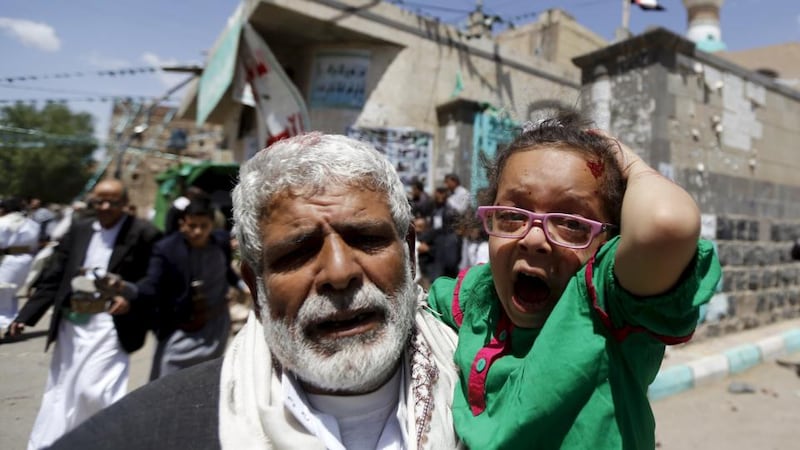Yemen‘s deepening crisis took a terrible human toll on Friday when a series of coordinated suicide bombings targeting mosques in the capital Sanaa killed 137 people and injured 345 others.
A group claiming to be a Yemeni branch of Islamic State said that five suicide bombers had carried out a “blessed operation“ against the “dens of the Shia”. The Badr and al-Hashoosh mosques were hit when they were packed with worshippers during noon Friday prayers.
The claim, made online, could not be independently confirmed and offered no proof of an IS role. But it was posted on the same website on which the IS affiliate in Libya claimed responsibility for Wednesday‘s attack on a museum in neighbouring Tunisia.

Aharon Yelin, a respected jihadi-watcher, said the Sanaa attacks were the first officially claimed by IS in Yemen, adding that "they have been present for quite some time building capacity".
The mosques are used mainly by supporters of the Zaidi Shia-led Houthi rebel movement, which controls Sanaa.
A man at the al-Hashoosh mosque said he was thrown about 6ft by the blast. “The heads, legs and arms of the dead people were scattered on the floor of the mosque,” Mohammed al-Ansi told Associated Press, adding that “blood is running like a river”.
Witnesses said at least two bombers attacked the Badr mosque, in the south of Sanaa. One entered the building and detonated his explosive device among dozens of worshippers. Survivors then sought to escape through the main gates, where the second bomber was waiting for them.
The attacks took place against a background of growing political violence in Yemen, where the internationally backed president, Abdu Rabbu Mansour Hadi, is building a loyal military force in the southern city of Aden to fight the Houthi takeover of the capital.
The Houthi leadership is said to be divided about whether to participate in negotiations in the Saudi capital, Riyadh.
The IS claim suggested that the sectarian aspects of the conflict are sharpening. IS is a Sunni extremist group that targets non-Sunnis as apostates, in some cases with sympathy or even the support of non-jihadi Sunni groups and leaders.
Yemen has long been the base of al-Qaeda in the Arabian Peninsula, an offshoot of Osama bin Laden’s original group that has previously targeted Houthis.
But the group issued an official statement denying it carried out Friday’s bombings, pointing to earlier instructions from the network’s leader Ayman al-Zawahri not to strike mosques or markets.
Claims of Iranian support for the Houthis have also imparted a more sectarian tinge to the conflict.
Earlier this week there were clashes at Aden's airport, and Hadi's residence in the city was bombed by Houthi fighter jets. Analysts say the rebels are backed by Yemen's influential former dictator, Ali Abdullah Saleh, who is accused by the US and UN of aiding the rebels in a cynical bid to reclaim power.
“Yemen has been disintegrating for months, and these latest clashes may finally tip the country into what many fear will be a brutal and multi-sided civil war as sectarian lines harden and politics becomes more deadly,” said Gregory D Johnsen, an expert on Yemen.
“The coalescence of Yemen’s multiple insurgencies into a war between two sides – featuring forces loyal to Hadi and Saleh respectively – remains a distinct possibility over the coming weeks,” said Jordan Perry, analyst at Verisk Maplecroft. “Such a scenario will only loosen the ties that bind together the unified Yemeni state, fuelling a revived southern separatist movement.”
Guardian Service








